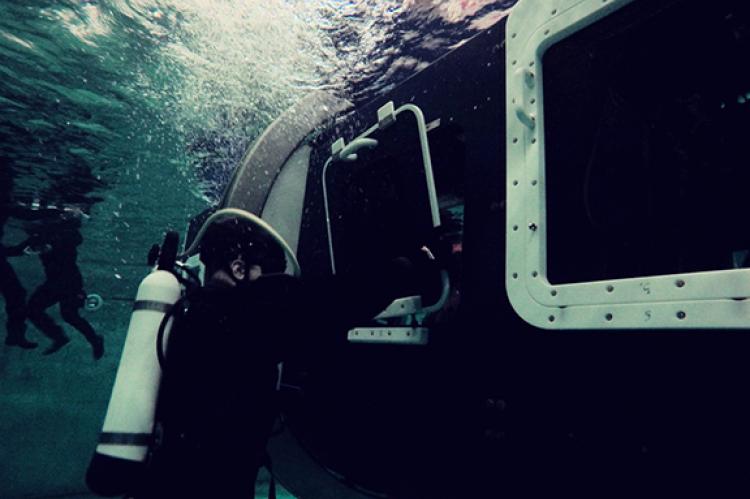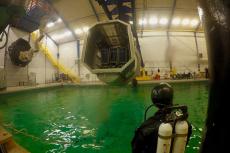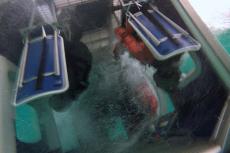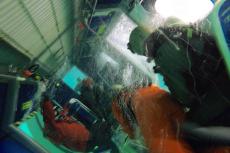Helicopter Underwater Escape Training
Falck Safety Services has been providing high quality safety and emergency preparedness courses and consultancy services to the offshore, military and aviation industries worldwide for more than 30 years. It is a division of Falck—a Nordic-based organization, which provides emergency assistance in case of accident and disease. Falck Safety Services offers a variety of offshore courses all accredited by OPITO [7]. The training center is located in Denmark and based in Esbjerg, on the western coast of the Jutland Peninsula.
Helicopters operating over water may experience emergencies, which require an immediate ditching. Ditching is a deliberately executed landing on water with the intent of abandoning the aircraft successfully. A helicopter that ditches onto a body of water is vulnerable to inversion and sinking due to its high center of gravity (engine, transmission and rotor) and its poor seakeeping performance [4]. The helicopters, operating over water, are equipped with Emergency Flotation System (EFS) and life rafts. The flotation system, once deployed, provides increased buoyancy and stability to the helicopter, thereby enhancing occupant survival rates. This, however, is not always the case; the flotation system can be damaged due to the impact of the landing or due to a malfunction, so the floats may not open symmetrically on both sides.
The first reported helicopter ditching occurred on 1 November 1944. The pilot of an R-4 Sikorsky helicopter, Second Lieutenant Jack Zimmerman, while taking off, had to ditch in the Pacific Ocean. The helicopter soon flooded and started sinking. The escape of the aircrew was difficult and Private William K. Troche was trapped in his seat. Zimmerman made several dives to the helicopter to extract him. Finally, he managed to extricate Troche from the aircraft before he drowned. Later, he received the Soldier’s Medal for his actions on that day [6].
In various studies, it has been reported that drowning is the primary hazard in this type of accident [1]. The discovery of oil sources in the North Sea in the mid-1970s sparked a huge demand of helicopter flights over water. Unfortunately, there was a sudden increase of helicopter ditching.
The UK Civil Aviation Authority, in 1984, saw no other solution but to make the Helicopter Underwater Escape Training (HUET) training a requirement for crew and passengers that regularly fly over water. This training, they added, should be as realistic as possible [2].
Helicopter Underwater Escape Training in Europe and most of the countries, Helicopter Underwater Egress Training in the United States is training provided to helicopter flight crews or passengers who fly over water as part of their job. These individuals could be military or law enforcement personnel, flight crews, as well as offshore and oil gas industry staff. We will refer to this training as HUET.
The HUET training is also delivered to pilots and aircrew members of small fixed-wing aircraft. As the name HUET implies, this training aims at providing the crew and passengers with the basic emergency response knowledge and skills to escape from the helicopter—or plane—successfully, following an emergency landing over a body of water. The phrase, body of water, covers any offshore environment, but it could certainly refer to a river or lake.
Facilities and training simulators
The training takes place in a purpose-built indoor pool. The pool measures 25m by 10m, has a depth of four meters, and a water temperature of 20°C (68°F). Through sophisticated systems, the instructors can generate wave and current conditions.
In addition, there is the ability of weather, sound and light simulation. Day and night lighting accompanied by various wind and rain strength conditions can be brought into the teaching process. The training incorporates real-life scenarios so participants get a better idea of what a real situation could feel like.
The area holds several Modular Egress Training Simulators (METS), which are designed and built in such a way to replicate different aircraft cabin types. The main training element is the helicopter simulator, which is also called a dunker.
The specific dunker model is the METS Model 30 by Survival Systems Limited. The METS™ Model 30 is the size of an S-61/Puma, Bell 212, UH-60, S-76, etc, and has eight interchangeable emergency exit panels. The Model 30 has become the international standard training simulator for use in delivering aircraft ditching training [8].
The dunker is held by a lifting system and operated by a crane operator. During the training, the dunker is sunk while being rotated. The simulator simulates the immersed cabin and can be turned left or right, up to 180 degrees in the horizontal plane.
In one side of the pool, there is a static helicopter rescue hoist trainer with a replica of a helicopter door. The hoist system is equipped with a strong light, which simulates the search light of a SAR (Search and Rescue) helicopter and produces a rotor downwash.
An additional training simulator at the facilities is the Shallow Water Egress/Escape Trainer (SWET). The SWET is a single-seat emergency trainer consisting of a seat enclosed in a protective metallic frame on which several flotation aids (buoys) are mounted.
With this apparatus, the instructors can easily operate the trainer while inverting it underwater and bringing it back to the surface. The SWET is the ideal training tool for the students to build their confidence and awareness while inverted underwater and breathing via the Emergency Breathing System (EBS), before they proceed to the HUET training.
Primarily, the military and law enforcement personnel use the specific simulator. However, civilian personnel perform similar training while inverted underwater in order to familiarize themselves with the underwater environment and their life support gear.
Another simulator is a two-seated emergency trainer built similarly to the SWET trainer. It simulates the cabin of a fixed wing aircraft. The crews experience and practice simulated aircraft ditching and emergency procedures.
Since the HUET training can be a part of bigger offshore survival courses, there are several different kinds of equipment in the indoor facilities, e.g., life rafts, ship evacuation systems and helicopter cabin simulators leading to a life raft.
Going under and around
There is a group within the Falck Safety Services, assigned with the task of training military and law enforcement personnel, called the Defense Group. Let us see how a typical training day looks like.
After the students have completed the required theory lectures, they get their personal gear and prepare themselves for the practical module. Before the training commences, the head instructor presents the training objectives and addresses the hazards related to the specific training activities, both on land and underwater. The training staff (instructors, safety divers, dunker/crane operator, and surface support) has established strict and to-the-point emergency procedures.
A short briefing is given each time the students go through a different training station. For instance, once the individuals are fastened to their seats in the dunker, the instructors will take them through the safety features of the simulator, such as the emergency air supplies located in different areas of the dunker, the quick-release seat belt mechanism, as well as emergency alarms.
A typical day of the METS training for military personnel consists of the underwater obstacle course, the SWET, and finally the HUET. The obstacle course aims to increase the confidence of the individuals in the underwater environment. Based on the client, the trainees will practice the HUET training in day and night conditions in different weather and wave states, and with a variety of personal gear. A drill may include the use of a life raft and the successful recovery by the static hoist trainer.
Before the trainees enter the water, the safety divers have already set everything up so there is no wasted time underwater. The safety divers will remain in the water for the duration of the training module. Apart from observing the crew and passengers during the training, they are responsible for placing the removable exits (windows) back to the helicopter at the end of each drill. The safety divers, in scuba gear, swim outside of the dunker monitoring the candidates at all times. The divers are trained to follow a specific emergency management protocol in case of an emergency. The same applies to the instructors and the dunker operator. The instructors stay in the dunker with the students. A typical number of trainees in the dunker is between five and six.
The dunker at the training center is also used for civilian training. A big number of students comes from the offshore and oil/gas industry. Those individuals are required to undergo the Basic Offshore Safety Induction Emergency Training (BOSIET) and Further Offshore Emergency Training (FOET), where the HUET is an essential module in both courses.
The trainees need to identify the emergency, brace for impact and properly use their EBS in order to escape the submerging cabin of the aircraft. Improperly operated lifesaving gear can lengthen or even prevent a successful escape from the cabin.
For example, regardless if one knows the location of the exits and the window jettison mechanisms, if the seat belt is released prematurely, the excess buoyancy force caused by the safety suit can significantly affect one’s escape from the cabin. Through the training, the needed situation awareness and effectiveness of the candidates is increased. The instructors bring in a variety of emergency scenarios while the degree of difficulty increases gradually towards the end of the course.
The defense personnel will also practice a range of more complex escapes in day or night, such as cross-cabin escape, in case there is one or more blocked exit points. Upon graduation, the instructors make sure that all the students have demonstrated the required competencies in theoretical and practical level.
Training saves lives
“The impact was tremendous. The helo lost power and dropped 500 feet in five seconds.”[5] This is an excerpt from a report following a ditching experienced by a US Navy helicopter crew. From this statement, it is obvious that the human information system does not have enough time to process what is happening. This applies to both the crew and the passengers. However, the objective is to egress from the aircraft rapidly and safely.
Training is a powerful tool for improving the survival rate following a helicopter accident in water. The crew and passengers have to train in a creditable underwater escape training simulator and should be prepared to repeat it as required by the guidelines. Through the training, they will gain essential decision-making and muscle memory skills that will assist them in the unfortunate event of an accident.
In an old study from 1978—still worth mentioning due to its significant findings—Cunningham reported on 234 US Navy helicopter accidents in water between 1963 and 1975. His findings were that the survival rate was 66 percent without HUET training and 91.5 percent with HUET training [3]. ■
References:
[1] Chen CT, Muller M, Fogarty KM. Rotorcraft ditchings and water related impacts that occurred from 1982 to 1989 — phase 1. Pleasantville, NJ: Galaxy Scientific Corporation; 1993. Report No.: DOT/FAA/CT-92/13.
[2] Civil Aviation Authority. Review of Helicopter Airworthiness Panel. (HARP). A report prepared for the CAA. U.K. 1984.
[3] Cunningham, W.F. (1978). Helicopter underwater escape trainer (9D5). AGARD Conference Proceedings, No 255 (Operational Helicopter Aviation Medicine), 66-1 – 66-3.
[4] EASA.2007.C16, Study on Helicopter Ditching and Crashworthiness. 2007.
[5] The Requirements for an Emergency Breathing System (EBS) in Over-Water Helicopter and Fixed Wing Aircraft Operations. Research and Technology Organization. RTO/NATO 2001.
[6] CollectAir Museum. http://collectair.org/zimmerman.html [Accessed 20/01/2016]
[7] Falck Safety Services. http://www.falck.com/safetyservices/ [Accessed 19/01/2016]
[8] Survival Systems Limited. http://www.survivalsystemsgroup.com/details.asp?ID=13&CategoryID=7 [Accessed 19/01/2016]
Download the full article ⬇︎
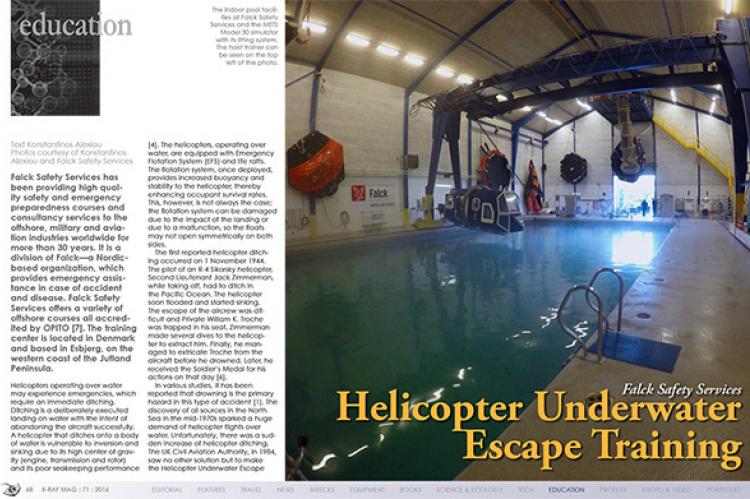
Originally published
X-Ray Mag #71
Great American Journey: Diving 50 States; Golfe-Juan on the French Riviera; Honduras' Roatán; Papua New Guinea's Manta Rays of Milne Bay; HMS Hermes Wreck; Accused of Involuntary Homicide: Malta vs Martin Case; Helicopter Underwater Escape Training; Scuba Confidential: Constructive Paranoia; Twilight Zone: Using Rebreathers for Coral Research; Applying Non-Technical Skills; UWPhoto: Science of Lighting; Harriet Mead portfolio; Plus news and discoveries, equipment and training news, books and media, underwater photo and video equipment, shark tales, whale tales and much more...


